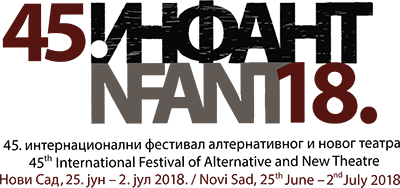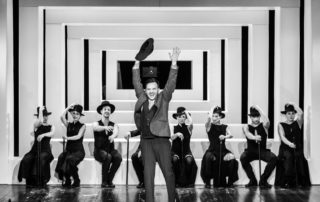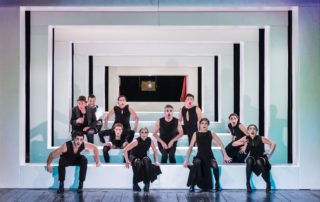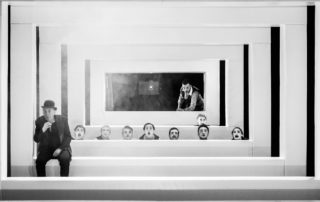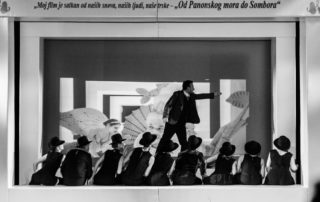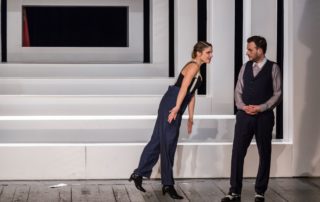IF SOMBOR WAS HOLLYWOOD
The National Theatre Sombor, Serbia
Authorial project by Kokan Mladenović inspired by the drama written by Radoslav Zlatan Dorić
Cast:
Ivana V. Jovanović
Marko Marković
Minja Peković
David Tasić Daf
Milijana Makević
Branislav Jerković
Vanja Nenadić
Nemanja Bakić
Dragana Šuša
Aleksandar Vučković
Danica Grubački
Musicians:
Irena Popović Dragović
Nikola Dragović
Composer: Irena Popović Dragović
Stage movement: Andreja Kulešević
Set design: Marija Kalabić
Costume design: Tatjana Radišić
Video: Mile Keskenović
Assistant composer: Nikola Dragović
Assistant directors: Olgica Nestorović and Tijana Markovinović
Expert consultant: Radoslav Zelenović
Running time: 90`
The Sombor Theatre was founded in 1882 and has been working continuously ever since then. The standing professional theatre has been active since 1946, and in 1952 it became the National Theatre. Leading directors of their respective generations have staged their plays in Sombor. In the last two decades, the National Theatre Sombor has been one of the most mobile in Serbia, having performed its productions in Hungary, Austria, Macedonia, Slovakia, Bulgaria, Cyprus, Slovenia, Russia, Ukraine and Montenegro, among other places.
In 1993 the National Theatre Sombor started a tradition of finishing each season with the “Theatrical Marathon” festival. It features a succession of productions of guest theatres, troupes and dramatic school students for three days and three nights. The Marathon finishes with a National Theatre Sombor’s play that premiered in the previous season.
The National Theatre Sombor has two stages: The Great and Small Stage – Studio 99.
Printer and cineast Ernest Bošnjak (1876-1963) is considered a pioneer of Yugoslav cinematography. He was the first to use the so-called “schwenk”, that is, moving camera, as early as in 1906. The Bošnjak’s idea of making Sombor a “dream factory” by forming in Sombor something similar to that which was later created in Hollywood, was forestalled by the Great War, but also by the narrow-minded attitude of the community and the authorities towards every idea that was new.
This fairy-tale like play has been staged in the silent film tradition, with movement and music as the main vehicles for telling the story to the audience.
“Ernest Bošnjak dared dream of Sombor becoming Hollywood, with the art of film propagating the prosperity of the town. But, following a typical matrix, this dream shattered down in the encounter with the conservatism and cowardice of local political leaders and in the community this dream was too great for. Are cities and people haunted by their crimes committed against the imagination of those who are bigger than their cities and communities? Are we still capable of visions of progress and collective dreams, or is reality what we are condemned to, a reality in which culture represents an unnecessary remnant of the times when dreamers and dreams still existed.”
Kokan Mladenović, director
The cast was speechless, while the audience was breathless! The idea of Kokan Mladenović […] seemed unusual in the beginning, but after all that we saw, we had the impression that it was only without any words that this story could be told. And it was told in the language of movement, play and facial expression.by the great young ensemble of the Sombor Theater in one breath.
Predrag Ćurčija, RTV
The cast have been given the greatest possible freedom to show all emotions by using only body language and facial expression. However, […] the ensemble of the play includes everything that once made Hollywood what it was: lights, sound, video, props, costumes, decors, sets, dressers, makeup, painters, locksmiths, carpenters, technicians. If you tried to take one of those elements away, it would result in a chaos!
Gorica Radmilović, magazine “Cult”
